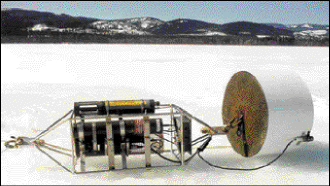
Underwater Sensor Needs No Calibration
Barbara Grant
Researchers at the University of Montana have developed an autonomous chemical sensor that can be used in long-term studies of CO2 dynamics within bodies of water.
Unlike most sensors, the fiber optic-based Submersible Autonomous Moored Instrument for CO2 could be operated without the need for calibration.

The Submersible Autonomous Moored Instrument for CO2 may be deployed in a steel mooring cage to study CO2 dynamics underneath lake ice. The sensor head is shielded by copper mesh to prevent interference from marine life and to quell algae growth during long deployment periods.
Carbon dioxide gas within the water diffuses into the sensor through a silicon rubber membrane, explained assistant professor of chemistry Michael DeGrandpre and graduate student Matthew M. Baehr. The gas then reacts with a solution containing the acid/base indicator bromthymol blue to produce carbonic acid, lowering the solution's pH and changing its color.
Whenever the CO2-indicator solution reaches chemical equilibrium, a solenoid pump delivers it into a fiber optic flow cell for absorbance measurements at three wavelengths.
The instrument's measurement system includes a spectrograph from American Holographic Inc. of Littleton, Mass., and three photodiode detectors supplied by Hamamatsu Corp. of Bridgewater, N.J. A tungsten light source manufactured by Gilway Technical Lamp of Woburn, Mass., provides illumination to the cell along a fiber optic cable, and another fiber optic cable carries the transmitted light to the spectrograph.
The researchers selected the measurement wavelengths of 434 and 620 nm to correspond with bromthymol blue's wavelengths of maximum acid and base absorbance. They ratio the 434- and 620-nm intensities by the intensity measured at a reference wavelength of 740 nm, and divide each value by a constant that is related to the measured intensity of distilled water at the corresponding wavelength.
A logarithmic computation, which is performed on each result, provides the two absorbance values. "The primary difference between this sensor and other fiber optic sensors that perform similar measurements is that the indicator solution within the membrane is periodically renewed to enhance sensor stability and sensitivity," DeGrandpre said. This long-term stability, as well as sensor-to-sensor reproducibility, could eliminate the need for calibration, he added.
DeGrandpre said that several of his team's instruments are deployed for months at a time on ocean moorings to collect data that global-change researchers will use to study the ocean's ability to regulate anthropogenic CO2. Sensors have also been deployed on a lake in western Montana to collect CO2 data under the ice and in ice-free conditions.
Published: September 1999